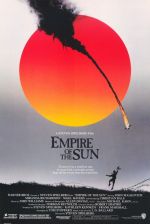
 I remember the movie’s poster when it came out in 1987. Steven Spielberg was already famous, though not the star that he is now but the movie was much talked about. I did not see it then, and it’s only recently that I realized its connection with old Shanghai.
I remember the movie’s poster when it came out in 1987. Steven Spielberg was already famous, though not the star that he is now but the movie was much talked about. I did not see it then, and it’s only recently that I realized its connection with old Shanghai.
Based on life of JG Ballard, Empire of the Sun tells the story of a young English boy left alone in Shanghai during the 1941 Japanese invasion of the International Settlement and his life throughout the war until being re-united with his parents in 1945. The most interesting was that the movie was fully filmed in Shanghai in 1986, before the real estate boom in Shanghai.
The first part of the movie takes place in the city itself and the remake of old Shanghai is simply stunning. The scene on the Suzhou creek bridge is exactly as one can see on the period photographs. The movie makers imported old cars and rebuilt parts that had been destroyed. The scene overlooking the Bund is also amazing with the level of details involved. The Bund used to be a street as well as a parking lot with a little cabin in the middle. The actual movie looks just like the old postcards. They even rebuilt the WWI victory statue that was destroyed during the Japanese occupation of the settlement. There is also a scene in front of a theater that is located just behind the Bund and was used as a club called New York New York a few years later. The movie perfectly rebuilt the crowd and atmosphere of the period and its clear that historians were involved to recreate the past. The most stunning was the documentary on the DVD, showing pictures of the Bund in 1986… helping to understand the enormous work involved for the decors. The film also involved hundreds (if not thousand) of people for creating the enormous crowd of refugees and people pushed back by the Japanese army invading the settlement. One scene was even filmed in the Peace hotel overlooking the Bund. The scenes with the Japanese army coming into the settlement are also very impressive, and must have brought back a lot of memories to many Chinese people who went through this period.
With a good knowledge of Shanghai, it’s also easy to spot the points that were not actually filmed on the spot. In particular, what is supposed to be the Cathay Hotel entrance (with a Cathay Hotel sign) is certainly not the actual hotel entrance. The villa where the boy live with his parents is also not in Shanghai. I have not seen any picture of this particular villa in Shanghai, and it would have been in a much too good state after 40 years of bad treatment. Moreover, buildings where built after 1949 in most gardens of the original villas as the density of people increase rapidely. I believe that the villa scenes inside and outside were filmed in England… in villas from the same period. The neighboring villas are Faux-Tudor like the ones in Shanghai and were probably built in the same period as well.
Finally, the camp scenes were not filmed in China. First of all, the sandy desert ground is surely not in the Shanghai region but looks much more like spain (one of the filming location). However, the style of the buildings re-created is very near to the original Shanghai style and the remake of the LongHua Pagoda (near which JG Ballart was actually interned) is also very close to the original. The only thing missing is the LongHua airport terminal that would have been between the tracks and the pagoda… i.e. exactly where the camp is build. One point I am not sure of yet, is where the green house of the ending scene is. It could be the one of the Shanghai botanical garden, but it also could be in many other places.
In any case, the remake of old Shanghai in the city itself is just amazing, and the attention to details given to the other parts of the movie make it a must see for Old Shanghai enthusiasts. For current Shanghai resident, it is amazing to see how Xu Jia Hui looked like before thre real estate boom of the 90’s and later. I wish the more recent movies about old Shanghai would pay such an attention to details.